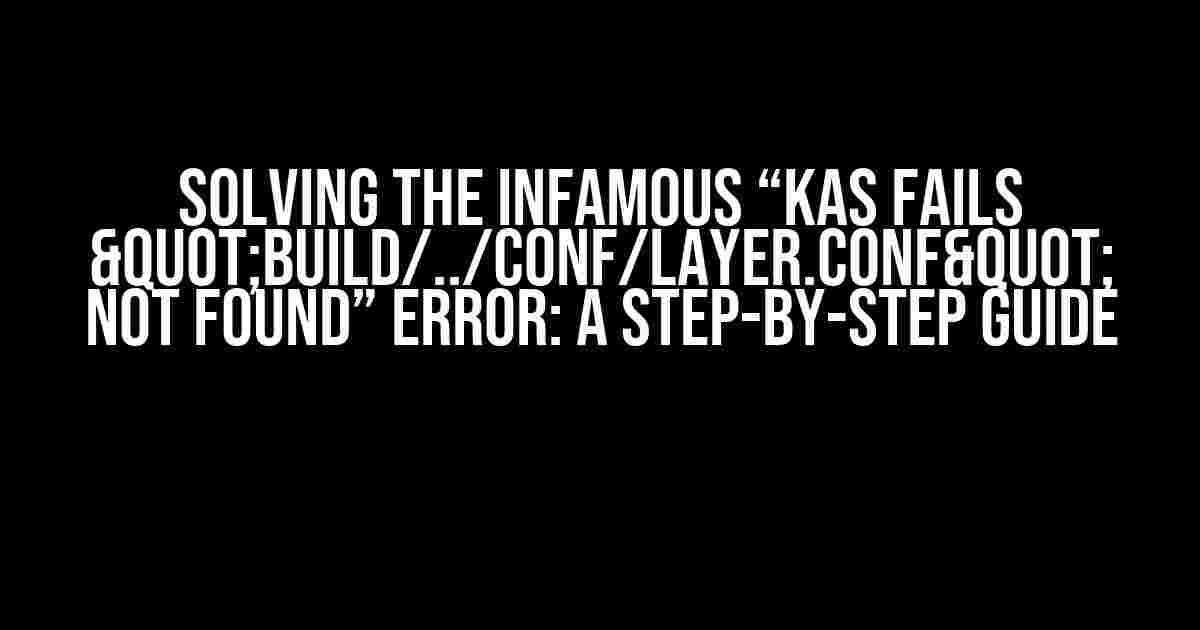Are you tired of staring at the cryptic “kas fails "build/../conf/layer.conf" not found” error message, wondering what on earth it means and how to fix it? You’re not alone! This pesky error has frustrated many a developer, but fear not, dear reader, for we’re about to dive into the depths of this issue and emerge victorious on the other side.
What’s Behind the Error?
Before we jump into the solution, let’s understand what’s causing this error in the first place. The “kas fails "build/../conf/layer.conf" not found” error usually occurs when attempting to build a Yocto Project image using the kas utility. The error message is telling us that the kas utility can’t find the `layer.conf` file in the specified location.
The Culprit: Relative Paths
The root of the problem lies in the way kas handles relative paths. When you specify a relative path in your `build/conf/local.conf` file, kas gets confused and starts searching for the `layer.conf` file in the wrong directory. Sounds simple, but it can be a real headache to diagnose and fix!
Solution Time!
Now that we understand the issue, let’s get down to business and fix it! Here’s a step-by-step guide to get you back on track:
Step 1: Verify Your `local.conf` File
Open your `build/conf/local.conf` file and examine the contents. Look for any relative paths specified for the `LAYERDIR` variable. If you find any, you’ll need to adjust them to absolute paths.
# Example of a relative path in local.conf
LAYERDIR := ${TOPDIR}/../layers/meta-mylayer
Step 2: Convert Relative Paths to Absolute Paths
Replace the relative paths with absolute paths. You can do this by using the `realpath` command or by manually specifying the full path.
# Example of an absolute path in local.conf LAYERDIR := /path/to/layers/meta-mylayer
Step 3: Check Your `layer.conf` File
Make sure your `layer.conf` file is present in the specified directory (in this case, `/path/to/layers/meta-mylayer`) and contains the necessary configuration.
# Example contents of layer.conf # Layer configuration BBFILE_COLLECTIONS += "meta-mylayer" BBFILE_PATTERN.meta-mylayer = "^meta-mylayer/"
Step 4: Update Your `kas.yml` File
Open your `kas.yml` file and ensure that the `layerdir` parameter is set to the absolute path of your layer directory.
layers:
- name: meta-mylayer
layerdir: /path/to/layers/meta-mylayer
Step 5: Run kas Again
Save all changes and run the kas utility again. This time, it should successfully find the `layer.conf` file and complete the build process.
Troubleshooting Tips
Still stuck? Here are some additional troubleshooting tips to help you overcome common issues:
-
Double-check your file paths and permissions. Ensure that the kas utility has read access to the `layer.conf` file.
-
Verify that your `layer.conf` file is correctly formatted and contains the necessary configuration.
-
Try specifying the `–layerdir` option when running kas to explicitly set the layer directory.
-
If you’re using a virtual environment, make sure it’s activated and configured correctly.
Conclusion
The “kas fails "build/../conf/layer.conf" not found” error might seem daunting at first, but by following this step-by-step guide, you should be able to resolve the issue and get your Yocto Project build up and running. Remember to keep those relative paths in check, and don’t hesitate to reach out if you encounter any further problems.
| Common Issues | Solutions |
|---|---|
| Relative paths in local.conf | Convert to absolute paths using realpath or manual specification |
| Missing or incorrect layer.conf file | Verify file presence and correctness, ensure necessary configuration |
| kas utility can’t find layer.conf | Check file paths, permissions, and layerdir specification in kas.yml |
Now, go forth and conquer the world of Yocto Project builds! If you have any further questions or need additional assistance, feel free to ask in the comments below.
Frequently Asked Question
Stuck with the “kas fails "build/../conf/layer.conf" not found” error? Don’t worry, we’ve got you covered! Here are some frequently asked questions and answers to help you troubleshoot the issue.
What causes the “kas fails "build/../conf/layer.conf" not found” error?
The error occurs when the KAS (KUKA Automation Systems) build process cannot find the layer.conf file in the specified path. This file is essential for building and configuring the KUKA robotics system. Missing or incorrect file paths can lead to this error.
How can I resolve the “kas fails "build/../conf/layer.conf" not found” error?
To resolve this error, ensure that the layer.conf file exists in the correct location and that the file path is correct. Check the build script and configuration files for any typos or incorrect references. If the file is missing, recreate it or restore it from a backup. Also, ensure that the KAS build process has the necessary permissions to access the file.
What is the significance of the layer.conf file in the KUKA robotics system?
The layer.conf file is a critical configuration file that defines the KUKA robotics system’s layer structure. It contains information about the system’s components, such as devices, axes, and interfaces. The file is used by the KAS build process to generate the necessary configuration files and binaries for the robotics system.
Can I modify the layer.conf file to customize my KUKA robotics system?
Yes, you can modify the layer.conf file to customize your KUKA robotics system. However, exercise caution when making changes, as incorrect modifications can lead to system instability or errors. It’s recommended to create a backup of the original file before making any changes and to test the modified file thoroughly to ensure it doesn’t affect the system’s functionality.
What are some best practices to avoid the “kas fails "build/../conf/layer.conf" not found” error?
To avoid this error, maintain a clean and organized file structure, ensure consistent file naming conventions, and regularly back up critical configuration files. Also, avoid manual editing of configuration files, instead, use established tools and scripts to modify the files. Finally, test the system regularly to catch any errors or issues early on.
